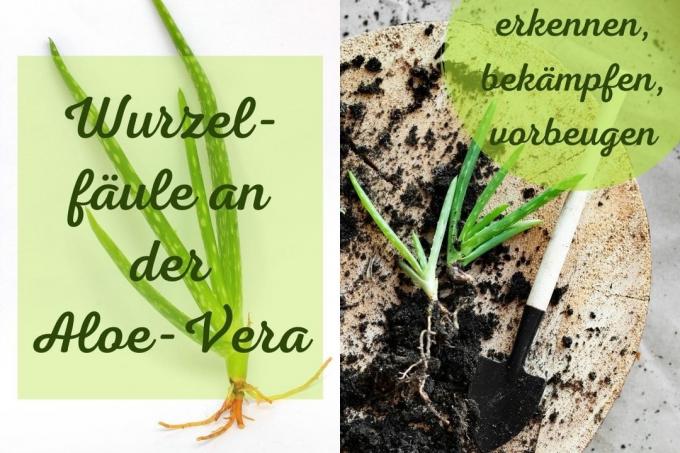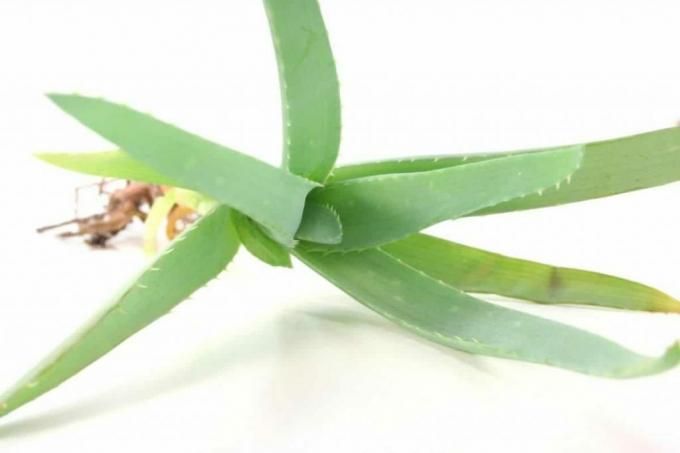
table of contents
- Recognize root rot
- causes
- Resuscitation - salvation
- Prevent
- frequently asked Questions
Aloe vera is becoming increasingly popular because of its appearance and its healthy properties. In the local latitudes it is cultivated as a pot plant. If cared for incorrectly, the aloe vera can quickly develop root rot.
In a nutshell
- Aloe vera is very prone to root rot
- likes it dry rather than too wet
- proper watering prevents the damage
- glassy soft leaves indicate root rot
- if not all roots are affected, the plant can often still be saved
Recognize root rot
Aloe vera in particular often suffers from root rot. If you recognize this quickly, you can still take countermeasures and possibly save the plant. The damage can be identified as follows:

- Watch the leaves closely
- become glassy and soft
- muddy over time
- Take the plant out of the pot
- Roots mushy
- Roots colored black
causes
The aloe vera is one Succulent plant. With this species, it is important to find the right dose of irrigation. Because if it gets too much water, this is usually the cause of the root rot. It is also important to watch out for waterlogging here. So, the following should be avoided when caring for:
- frequent watering
- too much water at once
- Water in the collecting plate
- Waterlogging
Tip: When you water the aloe vera, you should pay attention to the right time and wait if the soil is damp or wet. Succulents store the water in their thick, fleshy leaves and so can cope with prolonged drought. Therefore only water again when the soil is well dried out.

Resuscitation - salvation
If root rot was found after the plant was removed from the pot, you can quickly take countermeasures here and the aloe vera can often be saved. You should proceed as follows:
- cut off damaged, mushy roots
- leave healthy
- remove all affected leaves
- remove all soil
- Let the plant dry out in the air
- put in new, fresh substrate
Note: If you have been able to save the succulent plant in this way, you should definitely pay attention to the right care in the near future and, above all, only water the plant moderately.
Prevent
Proper care is the best prevention that helps against root rot in aloe vera. Because in this way the plant is strengthened and can develop well. Therefore, when maintaining and especially when watering, you should pay attention to the following:

- do not water excessively
- better let the earth dry in between
- Also hardly tolerates humidity
- Place in a warm, rather dry room
- The location can be sunny
- fertilize enough
- Use a suitable substrate
Note: If you want to choose the right soil for your succulent, it should be sandy and well-drained. Nevertheless, the aloe desires many nutrients and minerals. Therefore, special succulent or cactus soil is suitable for cultivation and healthy care.
frequently asked Questions
The succulent plant is usually not very susceptible to disease. Nevertheless, there are maintenance mistakes that you should absolutely avoid. Above all, waterlogging or excessively high humidity are to blame for the plant becoming sick. But too little light or a lack of nutrients can affect it. Therefore, good care is important so that the plant can stay beautiful and healthy for years to come.
This is generally not advisable in the local latitudes, because it is too humid and wet, usually also in the summer months. However, the succulent plant is in good hands in a pot that can move from location to location and can also be placed on the balcony or terrace in a protected place on warm days.
The whole plant then unfortunately no longer has a chance to survive. However, there is the possibility of removing a leaf that is still healthy and allowing it to re-root. For this purpose, the lower side of the leaf is put into a pot with potting soil and only moderately poured. After a while, a new root stem develops on this, the plant can be repotted. Correct care is then important here so that there is no renewed rot.
